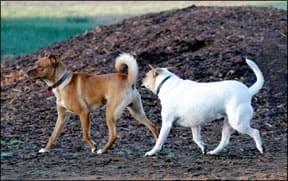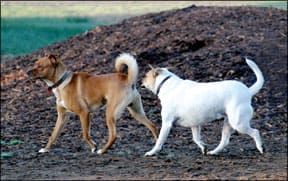It’s the stuff nightmares are made of. You’re relaxing on the sofa after a long day of work. The dogs have been walked, fed, and played with, and as you reach for the remote or your favorite book, out of the corner of your eye you spot one of your dog’s innocently dragging his bum across your bearskin rug! You have just been sacked by anal sacs.
Anal sacs are located on either side of your dog’s anus, between the external and internal sphincter muscles. Depending on the dog, they range in size from that of pea to a lima bean. Sebaceous glands within the lining secrete a foul-smelling liquid.

288
Under normal circumstances, the sacs empty on their own during bowel movements via a pair of ducts. This natural, routine emptying serves as a means of olfactory communication and establishing territory. Each dog possesses his own unique scent, which is why ritualized dog-to-dog greetings include copious rear-end sniffing. When a dog presents his rear for information gathering, the muscle movements involved in raising the tail apply pressure to the sac, prompting the release of additional scent.
Anal sac scent marking is also what makes dogs so interested in each others’ feces. A good whiff of anal sac intel can reveal a lot about the name, rank, and serial number of the depositor. Under normal circumstances, dogs successfully manage their anal sacs all on their own to the extent that many owners never even realize they exist. When problems develop, however, they are difficult, if not impossible to ignore (did we mention the strong smell?), and can quickly go from bad to worse, so it’s important to know what to look for and how best to respond to signs of trouble.
Location, location, location!
Knowing where to look is the first step in identifying potential trouble. It’s more challenging to examine the “business end” of a long-coated breed, but don’t let the added difficulty deter you. Raise the dog’s tail and examine the anal area. If the anus was a clock, the sacs would be located just below the opening at the five and seven o’ clock positions.
Not seeing anything suspicious is a good sign. You generally won’t see the sacs of healthy, problem-free dogs. In contrast, redness, irritation, heat, or obvious signs that the dog has been chewing at his backside are all signs of trouble. In extreme cases of anal sac abscess, the swollen, infected gland may be visible underneath the skin and is prone to rupturing. When signs of trouble exist, a trip to the vet is in order.
As with all routine pet care, it’s a good idea to practice often and reward with calm praise and a tasty tidbit. Routinely handling all parts of your dog will help make necessary inspections like this one less stressful for all involved.
Scooting
When good glands go bad, anal sac problems generally present as impaction, infection, or abscess. Impaction is the most common problem and is the result of an accumulation of secretions in the anal sac that the dog is unable to express on his own. This is typically caused by a thickening of the secretions or because the ducts from which the secretions exit the body have become temporarily clogged.
The most noticeable symptom of impacted anal glands is the “scooting” behavior where the dog drags his rear-end along the ground in an attempt to facilitate relief. Once they are impacted to the point that you see signs of your dog’s discomfort, the sacs need to be manually expressed by the skilled hands of a veterinarian, groomer, or brave dog owner who has been properly taught how to correctly do the deed.
Impacted glands are most often caused by consistently soft stool or after a short bout with diarrhea. When the stool is too soft, the sphincter muscle doesn’t apply enough pressure to empty the sacs as the dog expels feces.
Lack of proper exercise, excess body fat, poor muscle tone, and diet-related allergies are also contributing factors, according to Dody Tyneway, DVM, of Holistic Veterinary Center in Calabasas, California. Dr. Tyneway sees a high number of dogs who suffer from ear and skin issues along with repeated anal gland problems and says that, in the case of “itchy ears and rears,” it’s a good idea to look at a potential food allergy as the underlying source of trouble.
Diet is considered by many to play a critical role in managing and treating impacted anal glands. Once the problem sacs have been manually emptied, you can help your dog maintain her comfort by adding fiber to her diet; this will help bulk up the stool enough for muscle contractions to naturally move secretions along as the dog defecates.
You can add fiber to a dog’s diet via a bulk-forming laxative. Suggested sources of fiber include unprocessed wheat bran (1 to 5 tablespoons per day, depending on the size of your dog), Metamucil (1 to 5 teaspoons per day) or plain canned pumpkin (1 teaspoon to ½ cup). Your veterinarian may also recommend a high fiber prescription diet.
Dried fruit such as apricots, prunes, or figs; raw flax seeds; wheat cereal; fresh vegetables such as green beans, peas, or carrots; shredded coconut; wheat bran, and powdered psyllium husks have all been anecdotally linked to better anal sac management in dogs. When experimenting with food additives, start small. It’s recommended that fiber additives be soaked in water prior to consumption to help prevent possible intestinal blockage. Keep in mind that adding bulk-forming laxatives not only will increase the size of your dog’s stool, but also will promote more frequent elimination, so be sure to provide plenty of bathroom breaks.
Additionally, Dr. Tyneway recommends adding a solid source of probiotics; she likes those in the supplements offered by RX Vitamins (rxvitamins.com) or Sedona Labs (sedonalabs.com). Probiotics help maintain normal levels of healthy intestinal micro-flora and can be beneficial in normalizing bowl functions. She adds that while probiotics are also found in yogurt, they don’t exist in a quantity thought to be beneficial, so it’s best to use a supplement that has been independently tested to assure potency.
Additional dietary fiber to bulk up the stool and increased exercise to promote good gastrointestinal motility is all that’s needed to help most dogs regain the ability to “express themselves” on a regular basis. Nobody knows for sure why some dogs develop problems while others don’t.
“There seems to be an individual predisposition to develop anal sac problems or not,” says Lore I. Haug, DVM, DACVB, CPDT-KA, CABC, of Texas Veterinary Behavior Sciences in Sugar Land, Texas. Some dogs may always require a periodic assist. According to Dr. Haug, an occasional need (3-4 times per year) to have the sacs expressed is considered normal; if the dog requires this procedure monthly, it’s a sign of a bigger problem and the dog should be seen by the vet for a thorough rectal exam.
Prevention is really the name of the game, because when impactions worsen, the sacs can become infected. Anal saculitis is recognized by the presence of blood or pus in the secretions; and/or inflammation, swelling, and heat around the anal area. The dog may continue to scoot, lick, and bite at his rear; be reluctant to let you investigate the area; and display signs of discomfort when sitting or attempting to defecate. Depending on the severity of the infection, treatments can range from herbal and homeopathic remedies to antibiotics, given orally and/or injected directly into the sacs.
In extreme cases, the sacs can abscess, resulting in the signs of anal sac infection, along with fever, extreme swelling, and discoloration that usually transitions from red to a deep purple. Once the sacs have abscessed, they cannot be manually drained in an effort to produce relief and the abscess must rupture through the adjacent skin to create a drainage tract. If the abscess does not rupture naturally, it must be lanced by a veterinarian. Often, infected or abscessed sacs are so painful that the dog must be anesthetized in order to be treated.
Recipes for relief
When problems first present themselves, there are several at-home remedies owners can try, keeping in mind that signs of infection indicate the need for professional veterinary care. Richard Pitcairn, DVM, author of The Complete Guide to Natural Health for Dogs and Cats, recommends treating impacted anal glands with a hot fomentation of either marigold flower (Calendula officinalis) or red clover (Trifolium pratense) blossoms, to soften the contents of the sacs.
Stir a heaping tablespoon of the herbs into a quart of boiling water. Soak a washcloth in the solution until it’s just cool enough to handle. Apply the wet washcloth to the affected area, re-warming as necessary. Warming the area increases blood flow, softens the tissue, and can make expressing impacted sacs much easier.
Owners wishing to try a ready-to-use product might consider Anal Glandz by Native Remedies. This concentrated tincture is an herbal remedy consisting of annual nettle, dandelion, German chamomile, yarrow, and silica and is applied as a warm compress. The product is said to ease expression of impacted anal sacs while cleansing the anal area and helping prevent abscess.
Veterinarians who use homeopathy regard that modality as effective for anal sac abscesses. Dr. Tyneway adds that acupuncture or chiropractic treatments put an end to recurrent anal sac problems. In any case, a thorough rectal exam performed by a veterinarian is needed to rule out other problems such as tumors.
Hit the road, sac!
In extreme cases, vets sometimes recommend that the anal sacs be surgically removed. The decision to have your dog undergo this surgery should not be taken lightly, as it is not without risks, mainly that of trauma to the sphincter muscle resulting in poor muscle tone and fecal incontinence. Still, for some dogs and their owners, it can be the most humane, efficient, and cost-effective option available.
For the Ruhr family of Moorpark, California, choosing to have their Golden Retriever/Lab-mix’s anal sacs removed was a decision that came after nearly a full year of battling exceptionally problematic anal sacs. The scooting began when Hailey was six months old. Suspecting, as many dog owners do, that Hailey might have parasites, Wendi Ruhr took the dog to the vet, who discovered that the dog’s sacs were impacted. The sacs were expressed and Ruhr thought the problem was solved.
For the next year, if Ruhr didn’t take Hailey to the vet to have her sacs expressed every three to four weeks, she’d come home to discover that the dog had, in her words, “exploded” inside her crate. While normal anal sac secretions are minimal, Hailey produced and secreted far too much fluid. At her vet’s suggestion, Ruhr tried adding pumpkin to Hailey’s diet, changing kibble brands, and adding dietary supplements, all to no avail. Although there were never any signs of infection or abscess, they even tried a round of antibiotics injected directly into the sacs.
When nothing seemed to work, Ruhr met with a veterinary surgeon to discuss having the anal sacs removed and the decision was made. The surgery went well. Recovery required a difficult two weeks of antibiotics, stool softener, and pain medication, and required a great deal of effort to encourage Hailey to defecate, a behavior that was obviously painful in the days immediately following surgery.
Today, six months following the procedure, the family is pleased. Hailey has fully recovered, leads a normal life, and the only side effect seen by the Ruhr family is that she dislikes other dogs sniffing at her backside, a behavioral issue they are addressing with the help of a trainer.
Despite the potential for unpleasant complications, anal sacs are a normal part of your dog’s anatomy and should be treated as such. In most dogs, problems can be prevented by implementing general good health practices such as providing a healthy diet and regular exercise; maintaining your dog’s recommended body weight; making sure your dog always has a source of fresh, clean drinking water; and providing adequate opportunities and space for proper elimination.
Experts agree with the adage, “If it ain’t broke, don’t fix it,” advising against routine manual expression of otherwise healthy, problem-free anal sacs. At the same time, knowing what to look for can help you provide your dog with relief and proper medical care if and when problems present themselves in the (rear) end!
See “Resources,” page 24, for information on products and experts mentioned above.
Stephanie Colman is a writer and dog trainer in Los Angeles. She also provides twice-weekly training tips for the local NBC affiliate’s morning show, “Today in L.A.” She shares her life with two dogs and actively competes in obedience and agility. See page 24 for contact information.






